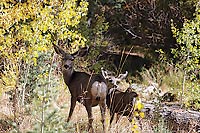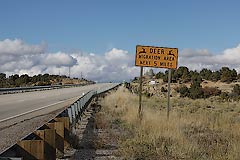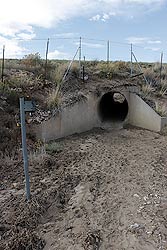|
|
 NATURE
HAPPENINGS September 2019 NATURE
HAPPENINGS September 2019
Desert Mulies
by Damian Fagan
Damian Fagan's blog |
Rocky Mountain mule deer are known for their large ears, seasonal movements, and ability to digest most landscaping on said migration. Their “see-food” diet includes grasses, forbs, shrubs, bird seed, mushrooms, vines, and tree leaves. A rule of thumb for gardeners living in deer habitat is don’t plant anything the deer can get to that you can’t stand to lose. Because you probably will.
Mule deer are in the genus Odocoileus which is derived from the Greek words odontos meaning “tooth” and koilos meaning “hollow.” Combined with eus meaning “pertaining to” the name refers to deep pits on the top of the grinding teeth.
In Utah, mule deer have been known to forage on over 800 different species of plants including sagebrush, bitterbrush, mountain mahogany, oak, willow, and cliffrose to name a few. The animals shift their diet from summer to winter forage, relying more on shrubs and woody material in the winter.
 As their name implies, these deer have large, mule-like ears that angle forward. The bucks have forked antlers which may still be covered in a soft-skin velvet which supplies blood and nutrients to the developing antler. This soft covering peels away or is rubbed off as the antler hardens in time for the rut. The antlers are shed in winter. As their name implies, these deer have large, mule-like ears that angle forward. The bucks have forked antlers which may still be covered in a soft-skin velvet which supplies blood and nutrients to the developing antler. This soft covering peels away or is rubbed off as the antler hardens in time for the rut. The antlers are shed in winter.
During late fall, males congregate with the females to breed. Larger males will drive away smaller rivals, but when a similar-sized buck appears, the two will use posturing or jousting to show dominance. This is an exciting and potentially dangerous time to watch such behaviors.
Fawns born in late spring after a 196 to 210-day gestation period. By the fall, the young will be around 70-80 pounds and still be with their mother.
 Studies in Oregon reveal that the fawns learn their migration routes from their mothers. Mountain ranges such as the La Sals, Abajos and Henries, shed their deer populations in winter as snow accumulates at the higher elevations. These deer move into the lowlands, often having to negotiate roadways and other barriers. Traveling through the region, motorists may notice high fencing parallel to the highways with periodic “jump outs” or open areas in the fencing where the deer can get away from the road. Studies in Oregon reveal that the fawns learn their migration routes from their mothers. Mountain ranges such as the La Sals, Abajos and Henries, shed their deer populations in winter as snow accumulates at the higher elevations. These deer move into the lowlands, often having to negotiate roadways and other barriers. Traveling through the region, motorists may notice high fencing parallel to the highways with periodic “jump outs” or open areas in the fencing where the deer can get away from the road.
The high parallel fencing along the highway funnels deer and other wildlife to underpasses, often culverts, that enables the animals to safely cross to the other side. Still, many roads are unfenced and pose problems to migrating creatures. Loss of wildlife through vehicle collisions has a dramatic impact on both wildlife populations and human safety.
In the fall, mule deer may gather into small groups or larger herds depending upon habitat and food resources. When alarmed, a deer may inflate its white rump hairs which is a visual signal to others that danger lurks. They may also vocalize or snort to alert others. Though mulies are fast runners and are able to change directions quickly, they fall prey to large predators such as mountain lions or coyotes.
Along with elk and bighorn sheep, mule deer have inhabited the Canyonlands region for thousands of years. Their continued existence is a goal of state and federal agencies, private organizations, and the public at-large and well worth the price of some devoured landscaping.
| Damian Fagan is an accomplished writer who has published a number of guide books as well as numerous articles. If you would like to read more or find out what Damian is up to follow this link to Damian Fagan's blog. |
|
| Colorado River Cleanup |
Join Canyonlands Field Institute (CFI) on Saturday, September 7th, for a fun-filled service project on the Colorado River! After a long summer of heavy use, the daily section of the river and its beaches, campgrounds, and banks need some cleaning up. Removing litter from these areas keeps the river ecosystem healthy for the wildlife that depends on it and the people that enjoy it.
This is your opportunity to give back to public lands and experience the feeling that comes with volunteering your time for a great cause. This activity is open all family and friends! Each service hour earned through CFI can be applied as a $15 credit toward any of our outdoor education programs for up to 40% of the trip cost, and parents can apply it to next year’s summer camps.
CFI will provide transportation, lunch, personal protection equipment, and boats and guides. Volunteers should be prepared for a full day on the river and bring water bottles, closed toed shoes or sandals with ankle straps, sun protection, and clothes that can get wet.
To RSVP please call 435-259-7750 or email development@cfimoab.org to sign up.
Canyonlands Field Institute is a non-profit outdoor education organization with a mission to provide quality outdoor education on the Colorado Plateau, to inspire care of wild places and to renew the human spirit. |
|
|
|
|
|
© 2002-2024 Moab Happenings. All rights
reserved.
Reproduction of information contained in this site is
expressly prohibited.
|
|


 As their name implies, these deer have large, mule-like ears that angle forward. The bucks have forked antlers which may still be covered in a soft-skin velvet which supplies blood and nutrients to the developing antler. This soft covering peels away or is rubbed off as the antler hardens in time for the rut. The antlers are shed in winter.
As their name implies, these deer have large, mule-like ears that angle forward. The bucks have forked antlers which may still be covered in a soft-skin velvet which supplies blood and nutrients to the developing antler. This soft covering peels away or is rubbed off as the antler hardens in time for the rut. The antlers are shed in winter. Studies in Oregon reveal that the fawns learn their migration routes from their mothers. Mountain ranges such as the La Sals, Abajos and Henries, shed their deer populations in winter as snow accumulates at the higher elevations. These deer move into the lowlands, often having to negotiate roadways and other barriers. Traveling through the region, motorists may notice high fencing parallel to the highways with periodic “jump outs” or open areas in the fencing where the deer can get away from the road.
Studies in Oregon reveal that the fawns learn their migration routes from their mothers. Mountain ranges such as the La Sals, Abajos and Henries, shed their deer populations in winter as snow accumulates at the higher elevations. These deer move into the lowlands, often having to negotiate roadways and other barriers. Traveling through the region, motorists may notice high fencing parallel to the highways with periodic “jump outs” or open areas in the fencing where the deer can get away from the road.